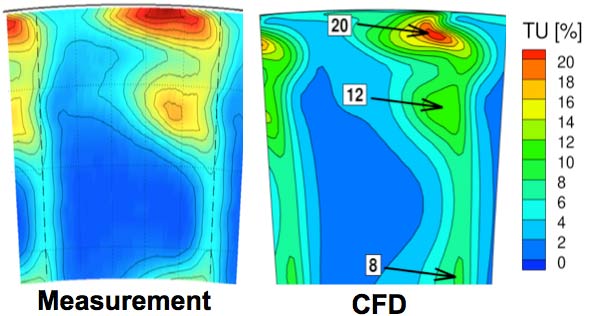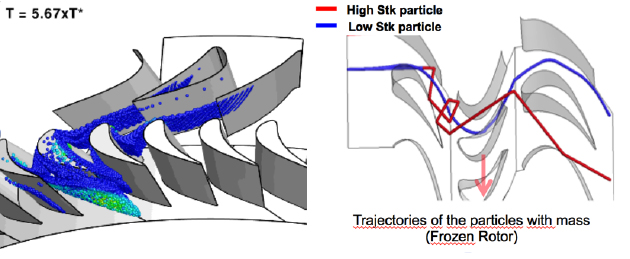Turbomachinery CFD
LEC’s in-house developed CFD toolset comprises of a pre-processor, the GPU accelerated unsteady RANS solver “MULTI3” and in-house developed post-processing tools.
LEC’s in-house developed GPU-accelerated CFD solver “MULTI3” solves the unsteady, three-dimensional, compressible Reynolds averaged Navier-Stokes equations on multi-block, hexahedral meshes. The unstructured data structure provides flexibility to the solver. Both the Ni’s Lax-Wendroff scheme and as well as Jameson’s 4th order Runge-Kutta based schemes are available. Giles type non-reflecting inlet and outlet boundary conditions are implemented to prevent the spurious oscillations from the truncated domain boundaries. The solver is also capable of modelling wet steam conditions.
For the closure of the URANS equations the zero-equation Baldwin-Lomax, one-equation Spalart-Allmaras, and two-equation Wilcox k-ω turbulence models have been implemented. The implementation of the k-ω turbulence model is based on the second order non-oscillatory, upwind discretization to ensure both the accuracy and the stability. The turbulence model implementation has been validated on turbulent flat plate simulations against correlations for the turbulent boundary layers. In addition to that, the predictive capability of the turbulence model has been investigated for the turbulence content of the secondary flow features downstream of the rotor as shown below.
MULTI3 is GPU-accelerated using a blend of “PGI Accelerator” directives as well as “CUDA Fortran” in order to reach good performance without considerably increasing the code’s development time. Using double precision accuracy running on a single “Nvidia C2050” graphic card based on the “Fermi” architecture, a factor 17 speedup in runtime has been achieved over a single core “AMD” CPU based on the “Istanbul” architecture. On a newer generation Kepler architecture based “ Nvidia K20x” graphic card a factor 30 speedup in runtime has been achieved compared to the single core performance of the same processor. Relative to the Intel’s more recent Sandybridge based architecture still a factor 15 performance could be achieved. MULTI3 has also been further MPI-parallelized with extreme care taken on memory management to reduce the communication overhead between the different graphic cards. The current parallelization is scalable for massive simulations covering over 100 GPU’s.
An unsteady particle tracking tool called “UNS-TRACK” has been developed at “LEC”. It is capable of simulating both massless particles and as well as particles with mass inside the turbomachinery. Particle tracking tool has been used to investigate the unsteady migration pattern of the temperature non-uniformities in the turbine (see below). The tool can also track particles with mass as shown where the collisions with the walls are modeled.


